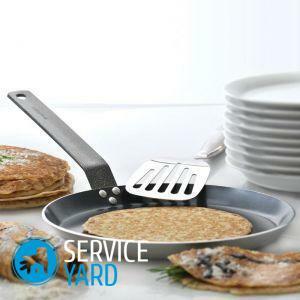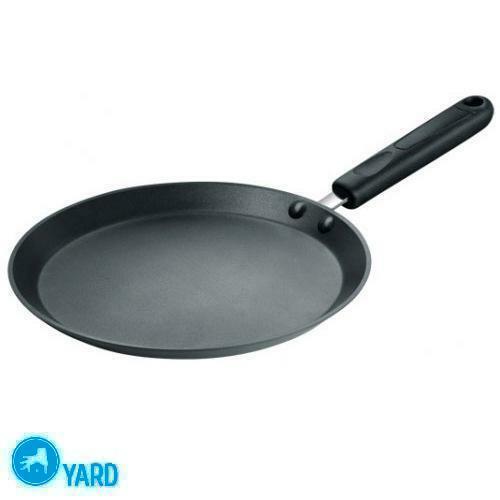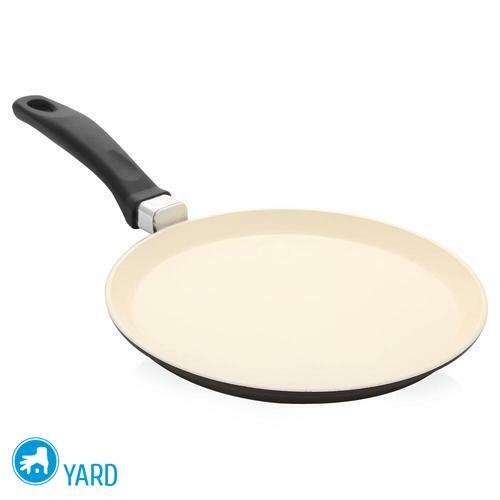
- Which pan for pancakes is better?
- Pancake frying pan materials
- Cast iron frying pans
- Frying pan aluminum and its main features
- Non-stick products - operation features
- Copper pail frying pan
- How to choose a pan for pancakes?
The most delicious, ruddy and roasted pancakes have appeared in the world of cooking for a very long time. In those days pancakes baked on simple metal sheets and they almost did not differ from tortillas. But only with the appearance of frying pans, the preparation of golden, thin, evenly fried, juicy pancakes became simple and affordable for housewives. In any house there should be a special good frying pan, because it is high-quality, comfortable dishes - the pledge of a delicious, appetizing and beautiful dish. Despite the abundance and variety of kitchen utensils in the shops, few know how to choose the ideal pan for pancakes, so that it will delight you and your family for a long time with delicate, lacy pancakes.
to the contents ↑Which pan for pancakes is better?
Many mistresses, from habit, fry pancakes in the frying pans, got from grandmothers and moms. But if you did not inherit such a good dish, then choose a frying pan, following simple but very important rules.
The ideal frying pan should have:
- Low sides.
- Ideally flat bottom surface( no terrain and sloping transitions).
- Long handle.
- Thicker bottom, allowing the dough to warm up evenly.

Important! The frying pan material should ensure an even distribution of heat.
The size of the utensils only affects the usability. For example:
- thin pancakes with a diameter of 15-16 cm are easier to turn over and faster to bake,
- large - a diameter of 20 cm can be folded several times and stuffed with any fillings.
Materials of the pancake pan
During cooking, the frying pan is subjected to a severe thermal shock when a cold dough is poured over a very hot surface over and over again. Therefore, not all dishes will survive this. Therefore, when deciding which pan for pancakes is better, first of all pay attention to the material from which it is made. Consider the types of pancakes, as well as their advantages and disadvantages.
Important! There are the following types of pans:
- Cast iron.
- Aluminum.
- With non-stick coating.
- Copper.
- With ceramic coating.
- With marble coating.
Cast-iron frying pans
In our mothers and grandmothers, such a pancake pan was an absolute favorite. And today many housewives prefer this kind of dishes, since it has a lot of advantages.
Important! The first dishes of cast iron appeared in the 3rd century BC.in China, and to this day the material pleases its strength and reliability.
Advantages:
- Reliability.
- Durability.
- The ability to evenly distribute heat throughout the surface.
- Safety for health.
- Excellent thermal inertness - cast-iron pancake pan slowly heats up and cools down for a long time, which allows you to quickly bake pancake dough.
- Excellent baking qualities - thanks to a thick bottom, pancakes have a unique taste and golden color.
- Does not deform from overheating.
- Porous structure - during frying, an oil film forms on the porous structure, which makes it easy to turn pancakes.
- Cost-effective - based on the previous advantage, there is no need to lubricate the surface every time before the next cooking.
- Thick bottom and walls.
- Can be used on any slab.
- Compatibility with any appliance and accessories - during cooking and turning the dish, you can use any of the devices from different materials, without being afraid to scratch the surface.
Disadvantages:
Although cast-iron frying pan is one of the "long-livers", it also has a number of drawbacks:
- Heavy. The smallest pancake pan with low bumpers weighs several kilograms.
- Does not like moisture. From the impact of water, rust often appears on cast-iron utensils.
- Needs special care.
- Price. A good quality cast-iron frying pan is not cheap, but the costs pay off, thanks to a long service life.
- Necessity of prefabrication. The new frying pan will have to be prepared for use - first calcined, and then oiled.
Advice for choosing and maintaining
When going to the store to choose a pan for pancakes, pay attention to:
- Surface quality - it should be flat, without any scrapes and other defects. Roughness should be barely noticeable.
- Boots - they should be low( 1-2 cm) - size select according to the favorite diameter of pancakes. But remember, than utensils is less, so it is easier.
Preparing for operation
Treat the new cast-iron frying pan as follows:
- Wash with warm soapy water.
- Wipe dry.
- Place on fire.
- Pour ordinary rock salt into the frying pan.
- Incense the frying pan over high heat for an hour( stir the salt occasionally).
- Repeat the procedure again for reliability. By the end of calcination, the salt will draw out all the fumes and technical oils used in the smelting of cast iron.
- Wash the utensils in warm water with soapy water.
- Thoroughly dry the frying pan.
- Pour 100-150 ml of refined vegetable oil.
- Incinerate the frying pan.
- Turn off the heat and allow the utensils to cool.
- Drain the oil - it can no longer be used.
- Wash the frying pan in warm water.

Important! During this treatment, a thin oil film is formed on the surface of the utensils, and it is very important not to damage it. Do not clean the frying pan with rough lips and brushes during preparation.
Care instructions
If you use a cast-iron frying pan just for baking pancakes, then treat it as follows:
- After finishing the frying, pour a little oil and add 2-3 tbsp.tablespoons of large table salt.
- Simmer the utensils over medium heat and drain oil.
- Wait - let the pancake fry cool.
- Bottom wipe with a cloth or clean dry cloth.
Frying pan aluminum and its main features
Food aluminum is a fairly safe material and lightweight. Aluminum was known for a long time - even before our era.
Important! Historians argued that when the emperor of Rome - Tiberius, a jeweler brought an elegant light plate, similar to silver, crowned, fearing that gold depreciates, ordered to cut off the jeweler's head. Repeatedly, aluminum appears in the 19th century and now for a long time.
Pros:
- Light weight.
- Minimum preparation before use.
- Cheapness.
Important! Aluminum frying pan is very light due to the fact that it has a high thermal conductivity. That's why heating it takes a couple of minutes.
Types of
A pancake pan made of aluminous aluminum is used today, which is covered with a special protective layer - the same as in the case of copper utensils.
A pancake made of aluminum is thin, medium or heavy cast with a thick bottom and the same walls.
Important! We recommend choosing exclusively thick pans, as they are more durable, heat quickly and keep heat for a long time. In addition, keep in mind that the pancake pan should have low sides.
Cons
Even for thick aluminum pans there are drawbacks, in particular:
- Toxicity in case of damage to the protective layer.
- It cools quickly.
- Subject to deformation. Aluminum is sensitive to mechanical damage. Therefore, in the process of turning over pancakes, use only a wooden spatula.
- Oil must be constantly lubricated when cooking. If pancakes burn, then you did not add oil or it did not get warmed up enough.
Important! Aluminum utensils do not require special care and preparation. New aluminum frying pan:
- Wash thoroughly in warm water with detergent and then in a flowing water.
- Wipe dry with a paper towel or cloth.
- Pre-heat and add a little oil before cooking.
- As soon as there is a haze - start to bake pancakes.
Non-stick products - operating features of
The most modern option is a pancake pan with Teflon coating, which makes the product non-stick. The types of coatings are great, and it can be applied to any metal surface: steel, aluminum, other alloys.
Important! Usually, the material affects the price and weight of the product, but the quality of the coating is very important.
Teflon
Cheap Teflon is widely blamed for the release of toxicity, but the full safety of expensive and certified coatings has not yet been proven. It is up to you to decide whether to prefer this kind of dishes or not.

Advantages of
To the obvious advantages of non-stick pans, you can refer to:
- Lightning ready to work.
- Small oil consumption.
- Simple care.
- Low price.
- Easy to use.
Cons
The disadvantages of the product are:
- The recommended heating temperature is 200-220 degrees. The coating reacts poorly to overheating - due to very high temperatures, Teflon can crack and begin to evaporate.
- Necessity of careful attitude to non-stick coating. Wash utensils can not be hard brushes, and you should not use abrasive detergents.
- The need to use special polymeric or wooden appliances. All metal objects: forks, knives should be kept away from the brittle coating.
Tips & Tricks:
- A pancake pan with non-stick coating should have a thick bottom, low sides and a comfortable handle. To properly decide which frying pan is best, give preference to the one whose edges and walls are thicker, so that in time the frying pan does not lose shape and is not bent.
- The cover for a pancake pan is not needed.
- Choose the diameters and sizes according to your preferences.
- Always monitor the power of the fire. Recently, there have been products with a thermosensitive indicator - a thermoset, which changes color as soon as the time comes to bake pancakes.
- Despite the fact that a special coating is applied to the pan, you need oil to make pancakes. First, pancakes will not be over-dried, and secondly - so you extend the life of the product.
- Since a pancake pan with non-stick coating does not tolerate temperature differences, after cooking, allow the frying pan to cool down, and then wash it.
Ceramic coating
Ceramics as non-stick coating is distinguished by its reliability and environmental friendliness. Outwardly, this product is a frying pan made of cast aluminum, with a smooth frying surface of dark or light color, unlike roughened Teflon.
Advantages of
The main advantages of such models are:
- High non-stick properties.
- Durability.
- Harmlessness and safety - ceramics do not emit harmful substances, even if the top layer is scratched.
- Easily tolerates heat.
- Ease of care.
- More resistant to scratches.
Cons
There are ceramics and drawbacks:
- The price is higher than that of Teflon products.
- Friability.
- Do not tolerate sudden temperature changes - do not place a hot pan under cold water, this will damage the coating.
Useful advices:
- If you decide to choose a frying pan for pancakes with ceramics, be careful, because often for ceramics produce an aluminum product with a thin layer of enamel. This model is short-lived, to the same - toxic.
- Each manufacturer recommends the use of ceramics with some accessories. Someone - only wooden scapula, and other products can carry and iron scrapers.
- Before the first frying, thoroughly wash the new ceramic frying pan and wipe with a clean cloth. Then, heat on medium heat and add a small amount of oil. Lightly burn on low heat, evenly distributing oil over the surface. Ceramic coating absorbs oil, and in such a frying pan you can later fry without it.
- After use and cooling, wipe the ceramic product with a sponge with warm water. Do not leave the frying pan not washed, as this will shorten its life.

Marble covering
Marble is a new word in the production of dishes. So far, only the world's leading companies have mastered the new technology. Marble covering is a logical extension of the ceramic material as a frying surface. Although manufacturers do not disclose the secret of the new technology, but in the product descriptions it is mentioned that natural marble and granite are used in the manufacture of non-stick coating.
Important! Marble ware are frying pans made of cast aluminum with a thick bottom and a non-stick coating of light color, which includes natural marble.
Advantages:
- The surface quickly and evenly warms up.
- Scratch resistant.
- Not toxic.
- Even without oil, pancakes do not burn.
- Spectacular view.
Disadvantages:
- High price.
Useful advices:
- Care for pans with marble coating is the same as for ceramic products. However, the marble coating does not require calcination.
- Qualitative marble is very difficult to scratch, but manufacturers still advise using soft instruments made of wood and polymers directly during cooking.
Copper Pancake Pan
Copper tableware is one of the oldest on the planet and is still in demand among professional chefs. However, it is unlikely that a frying pan for pancakes will be chosen for a housewife. The reasons for this are very important shortcomings.
Cons:
- High price.
- Complexity of care for copper utensils.
Important! The disadvantages, except for the price, can be attributed to the necessity of compulsory sipping of oil at each frying.
Pros:
- Thermal inertia - such a pancake pan very well holds the heat.
- Excellent heat-conducting qualities - quickly heats up, evenly warms up.
- Convenient weight - much easier than a cast iron product, but not as light as aluminum.
- Quality and reliability.
How to choose a pan for pancakes?
If you are determined with the material of the dishes, then before buying, listen to the following recommendations:
- The height of the sides should not exceed 1 cm - this ensures ease of turning. Some design models have sides from 2 mm to 10 mm.
- The length of the handle is not just safety. A cast iron or copper frying pan is always full of splashes of hot oil, so for these models, choose a handle that is more authentic.
- Choose dishes with a non-heating handle, otherwise - you have to work with a tack, which is not very convenient. Do not forget that the plastic handles melt over the fire, so give preference to the wooden ones.
- The bottom should be thick and even. The thicker the bottom, the longer the frying pan will last.
- Choose the shape of the dishes according to your preferences. Look close at the square frying pans, especially if you like stuffing pancakes: wrapping stuffing into a square pancake is more convenient. If the house has children, then choose a figurine with pictures or hearts.
We hope that thanks to this article, you have found the answer to the question, which frying pan for pancakes is better. It remains only to go to the store for a purchase, and let not one pancake be a "lump" for you.



